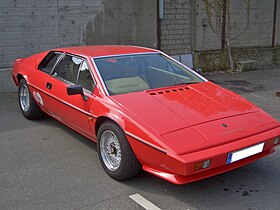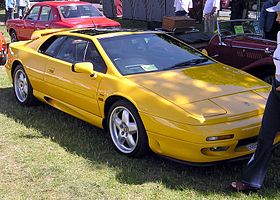Lotus Esprit
| Lotus Esprit | |
|---|---|
 |
|
| Overview | |
| Manufacturer | Lotus Cars |
| Production | 1976–2004 (10,675 built) |
| Assembly | Hethel, Norfolk, England |
| Body and chassis | |
| Class | Sports car |
| Body style | 2-door coupé |
| Layout | Longitudinal, Rear mid-engine, rear-wheel drive |
| Related | Lotus Esprit GT1 |
| Powertrain | |
| Transmission | 5-speed manual |
| Dimensions | |
| Curb weight | 2,690 lb (1,220 kg) unladen (typical) |
| First generation | |
|---|---|
 |
|
| Overview | |
| Production | 1976–1978 |
| Designer | Giorgetto Giugiaro |
| Powertrain | |
| Engine | 2.0 L type 907 I4 |
| Dimensions | |
| Wheelbase | 96 in (2,438.4 mm) |
| Length | 165 in (4,191.0 mm) |
| Width | 73 in (1,854.2 mm) |
| Height | 44 in (1,117.6 mm) |
| Second generation | |
|---|---|
 |
|
| Overview | |
| Production | 1978–1981 |
| Powertrain | |
| Engine | 2.0 L type 907 I4 2.2 L type 912 I4 |
| Third generation | |
|---|---|
 |
|
| Overview | |
| Production | 1981–1987 |
| Powertrain | |
| Engine | 2.2 L type 912 I4 2.2 L type 910/910S turbo I4 |
| Transmission | 5-speed manual transmission |
| Dimensions | |
| Wheelbase | 2,440 mm (96.1 in) |
| Length | 4,225–4,290 mm (166.3–168.9 in) |
| Width | 1,860 mm (73.2 in) |
| Height | 1,110–1,120 mm (43.7–44.1 in) |
| Fourth generation | |
|---|---|
 |
|
| Overview | |
| Production | 1987–1993 |
| Designer | Peter Stevens |
| Powertrain | |
| Engine | 2.0 L type 920 turbo I4 (Italy only) 2.2 L type 912 I4 2.2 L type 910/910S turbo I4 |
| Fifth generation | |
|---|---|
 |
|
| Overview | |
| Production | 1993–2004 |
| Designer | Julian Thomson |
| Powertrain | |
| Engine | 2.0 L type 920 turbo I4 2.2 L type 910S turbo I4 3.5 L type 918 twin-turbo V8 |
| Dimensions | |
| Wheelbase | 2002–04: 95.3 in (2,421 mm) 1993–2001: 96.0 in (2,438 mm) |
| Length | 1993–95 & 1999–2004 172.0 in (4,369 mm) 1996–98: 173.8 in (4,415 mm) |
| Width | 1993–95 & 1999–2001: 73.5 in (1,867 mm) 1996–98 & 2002–04: 74.1 in (1,882 mm) |
| Height | 45.3 in (1,151 mm) |
The Lotus Esprit is a sports car that was built by Lotus in the United Kingdom between 1976 and 2004. The silver Italdesign concept that eventually became the Esprit was unveiled at the Turin Motor Show in 1972 as a concept car, and was a development of a stretched Lotus Europa chassis. It was among the first of designer Giorgetto Giugiaro's polygonal "folded paper" designs. Originally, the name Kiwi was proposed, but in keeping with the Lotus tradition of having all car model names start with the letter "E", the name became Esprit.
The Esprit was launched in October 1975 at the Paris Auto Show, and went into production in June 1976, replacing the Europa in the Lotus model lineup. These first cars eventually became known as S1 (or Series 1) Esprits. With a steel backbone chassis and a fiberglass body, the Esprit was powered by the Lotus 907 4-cylinder engine, as previously used in the Jensen Healey. This engine displaced 2.0 L, produced 160 bhp (119 kW; 162 PS) in European trim 140 bhp (104 kW; 142 PS) in US/Federal trim, and was mounted longitudinally behind the passengers, as in its predecessor. The transaxle gearbox was a 5 speed manual unit, previously used in the Citroën SM and Maserati Merak; it featured inboard rear brakes, as was racing practice at the time. The Series 1 embodied Lotus' performance through light weight mantra, weighing less than 1,000 kg (2,205 lb).
The original Esprit was lauded for its handling and is said to have the best steering of any Esprit. However, it was generally regarded as lacking power, especially in markets such as the United States where the engine was downrated for emissions purposes. Lotus' claim of 0-60 mph in 6.8 seconds and a top speed of 138 mph (222 km/h) may be thought of as optimistic - actual road test times indicated 0-60 mph in 8 seconds and a top speed of around 133 mph (214 km/h).
...
Wikipedia
